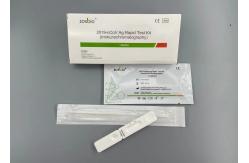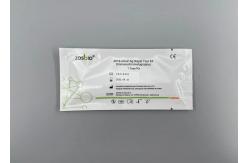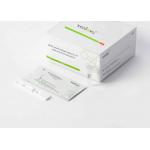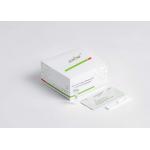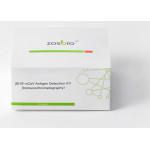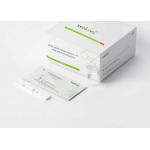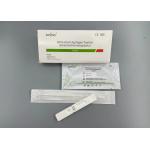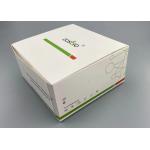2019-NCoV Ag Rapid Test (Immunochromatography) Usage Manual For
Self-Test Main Components
Intended Use
The kit is used for qualitative detection of 2019-nCoV Ag collected
from human nasal swab samples.
The 2019-nCOV, as a new type, is a type of nCOV. Can cause viral
pneumonia, the main clinical manifestations are fever, fatigue, dry
cough. A few patients are accompanied by nasal congestion, runny
nose, sore throat, diarrhea and other symptoms. critically ill
cases usually develop respiratory difficulties and / or hypoxemia a
week later, and severe cases rapidly develop into acute respiratory
distress syndrome, septic shock, difficult to correct metabolic
acidosis, and coagulation dysfunction.
This product qualitatively tested suspected nasal swab samples of
2019-nCoV Ag by lateral flow immunoassay. In the acute phase of the
infection, antigens are usually detected in nasal swab samples.
Positive results indicated the presence of viral antigens, but the
clinical relevance of patient history and other diagnostic
information was also necessary to determine the determination of
infection status. The positive results do not exclude bacterial
infection or mixed infection with other viruses.
The kit is used at home for laymen in non-laboratory environments
(such as a human home or certain non-traditional places such as
offices, sporting events, airports, schools, etc.). ). The test
results of this kit are for clinical reference only. It is
recommended to conduct a comprehensive analysis of the condition
based on the patient's clinical performance and other laboratory
tests.
Principle of Detection
The kit is an immunoassay kit based on the principle of double
antibody sandwich technology. The 2019 ncov monoclonal antibody
marked with the marker was sprayed on the binding pad as an
indicator marker. During testing, 2019 ncov-Ag in the sample was
combined to the labeled 2019 ncov monoclonal antibody to form a
Ag-AB complex. The complex moves upward through the capillary
effect until captured by another prepacket by a 2019 ncov
monoclonal antibody on the test line to form the sandwich complex.
A red strip appears in the T area of the 2019 ncov-Ag,
interpretation window in the sample. Otherwise, it is a negative
result. The Control Line (c) is used for program control. If the
test program is executed correctly, it should always be displayed.
Main Components
The kit consists of a test card, a sample buffer, and a swab.
Test card: composed of aluminum foil package, desiccant, test strip
and plastic card. Among them, the test paper consists of water
absorption paper, cellulose nitrate film, sample pad, binding pad
and rubber plate. The cellulose nitrate membrane T line (test line)
package was the 2019 nCOV Ab,C line (QC line) wrapped by the goat
anti-mouse polyclonal Ab, binding pad labeled 2019 nCOV Ab.
Sample buffer: phosphate, sodium nitride, etc.
Storage Conditions and Validity
Stay at 2 ℃ ~ 30 ℃, tentatively valid for 18 months.
The unpacking aluminum foil package is valid for one hour.
Production batch number: See the label for details.
Validity period: See the label for details.
Sample Requirements
(1) Nasal swab collection method: insert the sampling swab into the
nostrils, and insert the swab tip at 2.5 cm from the edge of the
nostrils. Roll the swab along the nostrils mucosa 5 times and then
repeat the process to the other nostrils with the same swab (see
Figure 1)
Figure 1 Collection method for nasal swab
(2) Sample treatment: The collected samples shall be treated as
soon as possible with the sample buffer provided as this kit (if
not immediately, stored in dry, sterile, sealed containers) and
stored within 2 hours not more than 24 hours ℃ ~8 ℃, kept at-70 ℃
(but avoid repeated freezing and thawing)
Test Method
Read the instructions carefully before testing. Return all the
reagents to room temperature before testing. The test shall be
conducted at room temperature.
1. sample processing (see Figure 2)
1. inserts the sample swab into the sample buffer and rotates near
the inner wall for about 10 times to dissolve the sample in the
solution as much as possible.
2. squeezes the swab tip along the inner wall of the tube to flow
as much liquid as possible into the tube, remove and discard the
swab.
3. Cover with the drops.
Figure 2 Sample
processing
Figure 3 Detection procedure
2. Test procedure (see Figure 3)
1. took out the exam card.
The 2. adds 2 drops (about 80 μ50) extracts the processed sample
into the loading hole of the test card and then activates the
timer.
3. read the results after 15 minutes at room temperature. Invalid
results after 20 minutes.
Interpretation of Test Results
Description of the test card (Figure 4):
Invalid ① result: Quality Control Line (C Line) no response line is
invalid and should be redetected.
② negative result: Quality control line (C) is red ribbon.
③ positive results: two red bands, test (T) and mass control (C).
Figure 4 Interpretation of test results
Limitation of test method
1. This product is used for qualitative testing and only for in
vitro assisted diagnosis.
2. This product is suitable for nasal swab samples. Results of
other sample types may be inaccurate or invalid.
3. must add an appropriate amount of samples for testing. Too much
or too small the sample size can cause inaccurate results.
4. The test results of this reagent are for clinical reference only
and should not be used as the sole basis for clinical diagnosis and
treatment. The final diagnosis can only be made after a
comprehensive evaluation of all clinical and laboratory results.
Product Performance Indicators
1. test limit: Using the inactivated novel coronavirus culture, the
minimum test limit of the kit was 6 × 102TCID50/mL.
2. is tested using company reference products and the results shall
meet Company's reference product requirements.
2.1 Qualification rate of positive quality control products: all
P1-P5 positive quality control products are positive.
2.2 Qualification rate of negative control products: all negative
control products N1-N10 are negative.
2.3 Detection limit: minimum detection limit reference product
L1-L3, L1 negative and positive L2 and L3.
2.4 Rereproducibility: J1 and J2, 10 times per time.
3. cross-reaction: The following concentrations of microorganisms
and viruses were added to the sample at a specified concentration
to assess their potential interference to the 2019 nCoV Ag test
program. The results show that there is no cross reaction and no
interference from various microbes and viruses.
| SN | Microorganisms | Concentration | Cross reaction |
| 1 | Coronavirus (HKU1, OC43, NL63 and 229E) | 1.0×105TCID50/mL | No |
| 2 | H1N1 influenza (new type A H1N1 influenza virus (2009), seasonal
H1N1 influenza virus), H3N2, H5N1, H7N9 | 1.0×105TCID50/mL | No |
| 3 | Influenza B (Yamagata strain, Victoria strain) | 2.5×105TCID50/mL | No |
| 4 | Respiratory syncytial virus | 2.8×105TCID50/mL | No |
| 5 | Group A, B, C of rhinovirus | 2.0×105TCID50/mL | No |
| 6 | Type 1, 2, 3, 4, 5, 7, 55 of adenovirus | 2.0×105TCID50/mL | No |
| 7 | Group A, B, C and D of enterovirus | 2.0×105TCID50/mL | No |
| 8 | EB virus | 2.0×105TCID50/mL | No |
| 9 | Measles virus | 2.0×105TCID50/mL | No |
| 10 | Human cytomegalovirus | 2.0×105TCID50/mL | No |
| 11 | Rotavirus | 2.0×105TCID50/mL | No |
| 12 | Norovirus | 2.0×105TCID50/mL | No |
| 13 | Mumps virus | 2.0×105TCID50/mL | No |
| 14 | Varicella-zoster virus | 2.0×105TCID50/mL | No |
| 15 | Mycoplasma pneumoniae | 1.0×106CFU/mL | No |
| 16 | Legionella pneumophila | 1.0×106CFU/mL | No |
| 17 | Haemophilus influenzae | 1.0×106CFU/mL | No |
| 18 | Streptococcus pyogenes (group A) | 1.0×106CFU/mL | No |
| 19 | Streptococcus pneumoniae | 1.0×106CFU/mL | No |
| 20 | Escherichia Coli | 1.0×106CFU/mL | No |
| 21 | Pseudomonas aeruginosa | 1.0×106CFU/mL | No |
| 22 | Neisseria meningitidis | 1.0×106CFU/mL | No |
| 23 | Candida albicans | 1.0×106CFU/mL | No |
| 24 | Staphylococcus aureus | 1.0×106CFU/mL | No |
4. interference: In the 2019 nCoV-Ag test program, the following
concentrations were added to the sample at a specified
concentration to assess their potential interference. The results
showed that all drugs did not interfere with the detection results
of the reagents.
| Interfering substances | Concentration | Interfering substances | Concentration |
| Mucoprotein | 1mg/mL | Ribavirin | 0.4mg/mL |
| Whole Blood | 1% | Fluticasone | 0.5mg/mL |
| Oxymetazoline | 10mg/mL | Dexamethasone | 5 mg/mL |
| Histamine hydrochloride | 10mg/mL | Triamcinolone acetonide | 5mg /mL |
| Tobramycin | 1mg/mL | Levofloxacin | 0.2 mg/mL |
| Oseltamivir | 1mg/mL | Azithromycin | 0.1 mg/mL |
| Zanamivir | 1mg/mL | Ceftriaxone | 0.4 mg/mL |
| Arbidol | 0.5mg/mL | Meropenem | 0.2 mg/mL |
5. hook effect: × of 106 TCID50/ ml, 2019 nCoV inactivated culture
was not observed in the high concentration range of 1.0.
6. Clinical Study: A reverse transcription-polymerase chain
reaction detection reagent was used as a contrast agent to evaluate
nasal swab specimens. 120 positive specimens were selected, 120
negative specimens (RT-PCR test) and tested with xiu reagent. The
results are summarized as follows:
| Nasal swab | RT-PCR | Sum |
| Positive | Negative |
| Positive | 116 | 2 | 118 |
| Negative | 4 | 118 | 122 |
| Sum | 120 | 120 | 240 |
| Sensitivity | 96.67%, (95%CI: 91.74%~98.70%) |
| Specificity | 98.33%, (95%CI: 94.13%~99.54%) |
Precautions
1. This product is used for in vitro diagnosis only.
2. This product is a one-time product and cannot be recycled.
3. shall read the instructions carefully before operation and
conduct the experimental operation strictly following the
instructions of the reagent.
4. avoids experiments in harsh environmental conditions, including
high concentrations of corrosive gases, dust, sodium hypochlorite,
acid-alkali, or acetaldehyde. Laboratory disinfection shall be
performed after the experiment.
All samples and reagents used by 5. shall be considered potentially
infectious substances and treated in accordance with local
regulations.
6. reagents shall be used within the period of validity indicated
on the outer package. The test card shall be used as soon as
possible after removal from the aluminum foil bag to prevent
moisture.
Logo interpretation
| Do not re-use | | Store at 2℃~30℃ |
| Consult instructions for use | | In vitro diagnostic medical devic |
| Batch code | | Use-by date |
| Keep dry | | Keep away from sunlight |
| Authorized representative in the European Community | | Manufacturer |
Basic Information
| ZHONGXIU SCIENCE AND TECHNOLOGY CO.,LTD Dingluan industrial zone ,Changyuan City,453400,P.R.CHINA Tel:+86-371-55016575 Email:zosbio@zosbio.com Web:www.zosbio.com |
| SUNGO Europe B.V. Olympisch Stadion 24, 1076DE Amsterdam, Netherlands |
Company profile
Zhongxiu Science And Technology Co.,Ltd., is a high-tech enterprise
engaged in the research and development, production and operation
of in vitro diagnostic products. The in vitro diagnostic products
developed by the company cover POCT series, microbial series,
biochemical series and immune series reagents and supporting
instruments.
The company has always adhered to the core concept of "fast and
accurate, living up to life", committed to providing society with
excellent products and services, and contributing to the cause of
human health.

